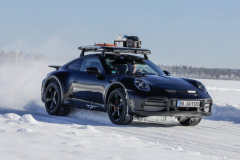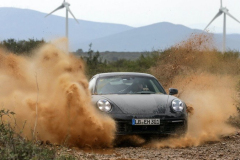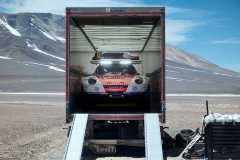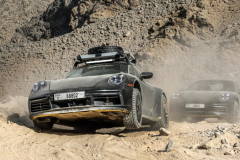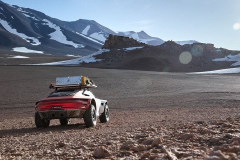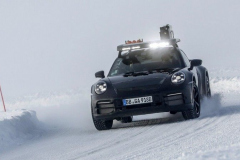Much like a certain poet, the Porsche 911 contains multitudes. Immediately after its inception, racing teams of all sorts took to the platform, building out the cars for any conceivable class of racing. Far before Group B came about in 1982 (which ultimately led to the legendary 959 supercar, among many others), it wasn’t uncommon to see Porsches used at rally racing events the world over. Rally use and development of the 911 really peaked with the cars run at the Paris-Dakar rally of 1984; it’s where the 911 was first fitted with all-wheel-drive, and where a substantial part of the 911’s legend was born. Almost paradoxically, rally- or safari-style 911s have continued to be a popular aesthetic for resto-mods and restorations for decades – even for vintage cars worth over six figures that will never be raced off-road.
It’s therefore a little bit hard to believe that in the year 2022, the bigwigs at Porsche would green-light a factory version of such a car. Not one dedicated to fuel economy or sustainable luxury, but one that will tug at the heartstrings of even the most jaded car enthusiast. Enter the 911 Dakar program, and the long, rough road that it took to develop the production car.
Sitting on Top of the World
Porsche has recently teased the birth of the new 911 Dakar in dramatic fashion over the backdrop of the high Chilean Andes mountains. A brief documentary teaser released on the interwebs shows a small team of engineers and mechanics, led by three-time Le Mans winner and Porsche factory driver Romain Dumas. Their mission? Only to drive two very special, highly-modified 911s to the top of the highest volcano in the world, Ojos del Salado. Reaching over 19,700 feet in elevation (higher than Everest’s base camp) before being stopped by excessive snow and ice, the cars made it without skipping a beat.
It’s not so subtly implied that these 911s were set up as test mules, part of research and development for the production Dakar. While few technical details of these mules have been released by Porsche as of press time, we can see that while both cars are clearly based on the 911 platform, there has been a tremendous amount of custom fabrication and chassis work, as is to be expected. Handmade aluminum rear bumpers serve to protect what’s left of the custom body work at extreme approach angles, and the front fascia have also been substantially modified in a cut-down manner for additional clearance. Large fender flares surround the beefy, Cooper All-Terrain tires wrapped around true beadlock rims, and we can also see that the front fenders have been “tubbed” for additional suspension travel. In total, the cars sport a whopping 350mm, or about 13.77”, of ground clearance. For reference, a Rubicon Wrangler sits at around 10” of clearance. Both cars also sport variations of safari-style roof racks, which were indeed used to haul mission-essential gear up the side of the volcano.
There are quite a few other modifications that were done to these cars to help them tackle the harsh climate and terrain of the volcanic Andes. A mechanical device that Porsche is calling their “Warp-Connector” was added, and appears to function much like a form of locking differential, typing the four wheels together and enabling traction when standard differentials would just spin their wheels. Additionally, the cooling system (radiators, intercoolers, hoses, etc.) needed to be relocated, while Aramid skid plates protect the underside of the vehicles.
While this small tease didn’t provide Porsche enthusiasts with many concrete specifics for the production car, careful scrutiny of the footage does reveal early prototype testing of some real-deal rally gear for the upcoming Dakar 911. Given the substantial resources that Porsche has poured into engineering these vehicles, it’s safe to assume that many of the lessons learned in this “volcano climb” have been incorporated into the production Dakar, just refined a bit for a production vehicle.
The 911 Dakar is Unveiled
After much anticipation and bated breath, the 911 Dakar was finally unveiled to the public at the Los Angeles Auto Show on November 16, 2022. Sure enough, the production car remains true to what’s been seen in the teasers, spy shots, and online rumor mills. Porsche themselves are very proud of the pedigree of this new car, and are even billing it as “the first two-door sports car to offer outstanding off-road capabilities.” 10,000 kilometers of off-road testing in every imaginable environment took place, including frozen lakes in Sweden, desert dunes in Morocco and Dubai, and of course many miles of pavement testing. In addition to Dumas, a bevy of respected racing drivers have had their turns with the Dakar during testing and development, including Walter Rohrl and Jorg Bergmeister, and according to their testamonials in Porsche’s press material, this car is going to be a future classic.
Clearly based on the existing 992 Carrera platform, the first thing you’ll notice immediately is the ride height. It looks to ride at least several inches higher than a standard Carrera, and a carefully designed front splitter works to maximize vertical clearance and add to the aggressive, high-clearance look. The production Dakar will come with all-terrain tires, likely Coopers, and much care has been taken to retain the superb driving experience that the 911 is known for on the road despite the increased ride height and different tires than normal. The press photos, as well as photos from the Chile expedition, also show the Dakar will have a deployable rear spoiler in line with the rest of the Carrera models. Roof racks will be available, although it’s unknown at this time whether they will be the standard equipment or the option, or how many variants might be available to choose from. While the car does look smart without the roof rack, it’s hard to imagine a true-blue rally Porsche without one.
There’s also a lot going on in the software in order to make this whole package work as well as it does. The ABS system has been tweaked heavily and optimized for breaking on loose surfaces (where traditional ABS would have a difficult time figuring out what’s going on), and the suspension has also been reinforced and specifically designed to handle a variety of terrain types. At the end of the day, it seems likely that the Dakar will be just as mean of a street machine as any other 911. During testing, Bergmeister complimented the on-road behavior: “I wouldn’t have thought that a vehicle with such ground clearance and all-terrain tyres would still feel like a Porsche 911 on asphalt.” We’ll know more about all of the neat engineering feats on the Dakar in the coming months and are looking forward to taking a deeper dive into the chassis and driveline to discover what makes this such a special automobile, but for now, it certainly looks the part, and it definitely looks like it will be able to play the part, as well.
Looking Ahead…
If you’re an internal combustion engine, you’ve seen better years than 2022. Fuel economy and emission standards are being pushed harder than ever before as many manufacturers seek to transition exclusively to electric power within the next decade. Gone are the displacement wars of the 1990s, and largely gone are the horsepower wars of the 2000s. Heck, if you’re a fan of motorsports at all, you can’t help but feel some amount of doom and gloom.
Despite all of this change and the feeling that car companies are getting a little more serious these days, Porsche themselves doesn’t seem to have lost any of their enthusiasm for their internal combustion-powered sports cars at all. Put simply, on paper, the new 911 Dakar probably shouldn’t be coming down the pipeline at all. It’s a completely ludicrous homage to the golden era of automobiles and brilliant engineers, to whom nothing was impossible. The times may change, but engineers don’t. We’re all the better for it that Porsche let their dreamers and engineers run this project and build the Dakar to their dreams. The result is already shaping up to be a modern classic, and one of the most exciting sports cars of the 21st century. We can’t wait for these to hit the streets, and other places, too.
Photos


